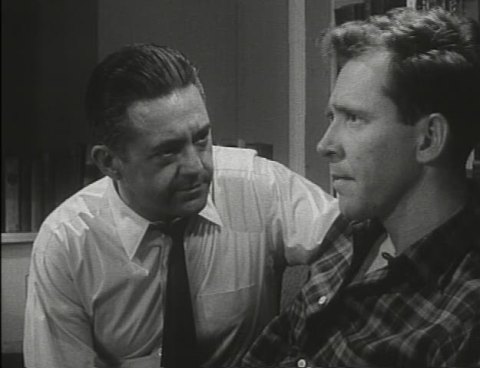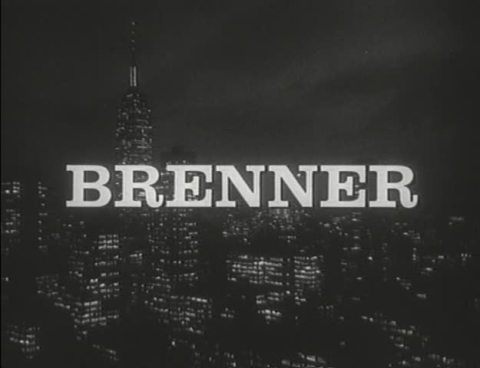Corrections Department #3: Notes on Brenner
July 8, 2008
Last month one of the more fascinating forgotten shows of the fifties made its home video debut. Timeless Media’s new box set of fifteen episodes of Brenner marks the first opportunity that TV fans, and even veteran collectors, have had to sample this series since its original network run nearly fifty years ago. I’ve written about a few figures connected tangentially to Brenner – Frank Lewin, the composer who supervised the music and probably composed the terrific, minimalist jazz theme, and Sydney Pollack, a bit player visible on the periphery of several episodes as young plainclothes cop – but even I had never been able to take a close look at the show until this DVD collection went into production.
Brenner‘s historical significance derives mainly from its pedigree. Its executive producer was Herbert Brodkin, a former set designer who became perhaps the last of the important producers of quality dramas in the waning days of live television. Taking the reigns of NBC’s Alcoa Hour/Goodyear Playhouse and then CBS’s Studio One and Playhouse 90 during their later seasons, Brodkin produced key live dramas including Horton Foote’s “The Traveling Lady” and “Tomorrow,” Rod Serling’s autobiographical “The Velvet Alley,” and the original “Judgment at Nuremberg” – the one during which the sponsor, the American Gas Company, insisted that all references to the gas chambers be deleted. Brodkin’s second act came in 1961, when he launched The Defenders, a Reginald Rose creation that raked in a roomful of Emmys and became the most important TV drama of the early sixties. Brodkin’s other sixties shows – The Nurses, For the People, Espionage, and the cult failure Coronet Blue – were less successful but helped to define his reputation as a standard-bearer of uncompromising quality as television became more and more conventional. It was a reputation that continued into the seventies as Brodkin, like most of the talented people in television, shifted his attention to movies of the week and miniseries. Pueblo, The Missiles of October, and Holocaust (also recently released on DVD) were all Brodkin efforts.
Brenner, made in 1959, was a transitional project for Brodkin. It was his first independent production, his first series to be shot on film, and (aside from his first producing assignment, NBC’s live Charlie Wild, Private Detective) his initial concession to the reality that programs with running characters were quickly supplanting the anthology drama. Like The Defenders and The Nurses, Brenner was based on a one-shot anthology show from Brodkin’s catalog, a January 1959 Playhouse 90 entitled “The Blue Men.” Intriguingly, Alvin Boretz, who wrote “The Blue Men,” is not credited as the creator of Brenner, although he did contribute scripts to the series.

Edward Binns and James Broderick as the Brenners
So just what is the show about, exactly? It’s a modest police drama that centers on not one but two characters who give their names to the series’ title: Roy Brenner (Edward Binns), a no-nonsense, seen-it-all plainclothes NYPD lieutenant, and his son Ernie (James Broderick), a rookie beat cop. Viewers familiar with the first season of the better-known Naked City and the underappreciated Decoy (a syndicated show with the sexy Beverly Garland as a tough, beautiful pre-feminist policewoman) will find that Brenner shares much of its flavor, its taut little stories that blend character drama with action (and not always smoothly), with those shows. The primary difference is that, while Brenner too was shot on location in New York City, it takes little advantage of the panorama of awesome cityscapes that give Naked City and Decoy their visual richness. Like The Defenders and The Nurses, Brenner plays out mainly on interior sets.
That may be disappointing to some who hope to get a time-capsule snapshot of Manhattan circa 1959; certainly I had to adjust my expectations a bit when I began studying the Brodkin shows after considerable exposure to the location-rich East Side/West Side and Naked City. But Brenner has other virtues, in particular some conceptual subtleties that you won’t find in Decoy or the half-hour Naked Citys.
For one thing, although Brenner never quite develops into a serialized story, it is a bildungsroman of sorts that places a great deal of emphasis on Ernie’s growth as a cop. The episode “Departmental Trial” makes a point of telling us that Ernie is in his first year on the force, and others chart the lessons he learns from his mistakes, and his acceptance or rejection of the examples set by various older cops.
And the emphasis there is on rejection, because of another unusual element of Brenner. Roy Brenner’s assignment within the police department is on the Confidential Squad, or what we’d now call “internal affairs”: he investigates allegations of corruption among other cops. Fully half the episodes in this DVD set focus on some allegation of police malfeasance. “Small Take” and “Thin Ice” are about beat cops accused of taking bribes or turning a blind eye to a gambling racket. “Monopoly on Fear” stars Milton Selzer as a plainclothesman charged with cowardice – he’s six months away from retirement and starting to lose his nerve – and “Laney’s Boy” deals with cops who cover up a punk teenager’s petty crimes because his father is a beloved police sergeant.
Roy Brenner ends up exonerating as many police officers as he takes down. But viewed in total, Brenner projects an attitude that’s almost perversely anti-police, even by the modern standards of something like the cynical The Shield. Though the execution is less forceful, it’s this element that links Brenner most closely to the crusading social criticism undertaken in The Defenders and The Nurses. I have no idea if Brenner enjoyed police cooperation in its filming or not, but you have to imagine that if anyone from the NYPD ever paid attention to the scripts, they’d have gotten mightily steamed.
Brenner was produced by Arthur Lewis, a Broadway veteran who died two years ago. (Brodkin, essentially an impresario and still working simultaneously on Playhouse 90, received credit as executive producer.) Lewis went on to produce the first season of The Nurses, and so many of the same key talents behind that show were also the most prolific contributors to Brenner: the directors Gerald Mayer and Herman Hoffman, and writers like Boretz, George Bellak, and Art Wallace. You might call them Brodkin’s “B team” – solid mid-level craftsmen from the pool of New York, live TV-trained talent, but not the superstars who would form the more exclusive creative staff of The Defenders.
A few big names did pass behind the cameras of Brenner. The great Ernest Kinoy wrote one episode (“Crime Wave,” sadly not in the DVD set), and Peter Stone, a journeyman TV scribe before Charade made him famous, contributed several. Steven Gethers, later Emmy-nominated for his work on The Farmer’s Daughter, wrote perhaps the most compelling episode in the DVD collection, “Crisis.” It’s a sensitive, almost entirely personal story in which Roy Brenner falls in love with a woman (Hildy Parks) who cannot come to terms with the element of danger in his job.

Gene Hackman as “Patrolman Claiborne”
Then, of course, there are the actors. As with any New York-based show of this era, one can have an enormous amount of fun trying to spot all the soon-to-be-famous young performers just launching their careers. George Maharis, Jerry Stiller, Al “Grandpa Munster” Lewis, Mitchell Ryan, and Clifton James all turn up in the episodes on the DVDs. The X-Files‘ Jerry Hardin has a role with no lines in “Departmental Trial,” and Bruce Kirby appears without credit in “The Vigilantes.” Brenner somehow had a special knack in casting the roster of patrolmen who have recurring roles in various episodes. Along with Sydney Pollack, Gene Hackman and Dick O’Neill were among this group. Oh, and there’s one episode in which sixties leading lady Carol Rossen is visible as an uncredited, non-speaking featured extra. Can anyone spot her?
*
I’ve filed this piece in the “Corrections Department” section because Brenner has languished in such obscurity over the years that virtually nothing has been written about it – and much of what’s out there is inaccurate. Most reference books describe Brenner as a father-and-son cop show – a reduction that makes it sound like some hoary Pat O’Brien melodrama from the thirties – without mentioning more substantive aspects of the premise (Ernie’s inexperience; the “rat squad” angle). Every source I’ve come across, in print and on-line, contends that Brenner filmed an initial batch of episodes in 1959 and then briefly resumed production again in 1964 to create ten more episodes.
That’s a highly unusual production history of which I’d always been skeptical – why would CBS choose to revive a failed, forgotten show, and why would Brodkin and the two stars participate, five years further on in their careers? The copyright dates on these episodes finally confirm my suspicion – that the entire Brenner series was created in 1959, and that the show’s summer replacement run on CBS in 1964 was simply a burn-off of unaired segments.
Any reference you consult, apart from an exhaustive catalog compiled by the Museum of Broadcasting (now the Paley Center) for its 1985 Brodkin retrospective, will tell you that there are 25 Brenner episodes. Actually there are 26 – sort of. As was common at the time, Brodkin used the series’ final production slot to film a “backdoor pilot” for a proposed spinoff called Charlie Paradise. (The episode itself is called “The Tragic Flute.”) Just as Brenner emulated Naked City, Charlie Paradise was a pretty blatant attempt to join in on the wave of cool private eye actioners that followed upon the success of Peter Gunn and Richard Diamond, Private Detective. Charlie (Ron Randell) is the proprietor of an ultra-hip coffee house, a sort of godfather of Greenwich Village to whom Roy Brenner turns for help in navigating the wacky world of beatniks.

Fred Gwynne, Severn Darden, Gerald S. O’Loughlin, and Ron Randell in Charlie Paradise
Presumably, had the series sold, Charlie would’ve been an amateur sleuth along the lines of John Cassavetes’ Johnny Staccato, and one imagines that the New York location shooting might have offered an authenticity exceeding that of any of the other “jazz-eye” shows. But “The Tragic Flute” is undistinguished; it tries for a light-hearted flavor that trades too heavily on the supposed exoticism of the beat world. (The writers were James Yaffe and Peter Stone, working here more than on his other Brenners in the comic mode that won him the Oscar). Broderick doesn’t appear in the segment at all, and Edward Binns looks exquisitely uncomfortable as he plays straight man to all the kooks (which include Roberts Blossom as a beat poet, and Fred Gwynne as a character named Frances X. Fish). Taken out of context Charlie Paradise is simply baffling, and it might have been wiser for Timeless to segregate it as a bonus feature on the DVDs.
As for those DVDs, the image quality is exceptional – far superior to the often battered, sixteen-millimeter derived copies of the early Universal shows (Arrest and Trial, Checkmate) that Timeless has been releasing lately. Unfortunately, I’m told that unless another print source is found, this will be a standalone “best-of” release. It would be wonderful to have the other eleven Brenners on DVD someday. It would be even more wonderful if CBS/Paramount would open up its vaults and give us The Defenders, The Nurses, and Coronet Blue.
